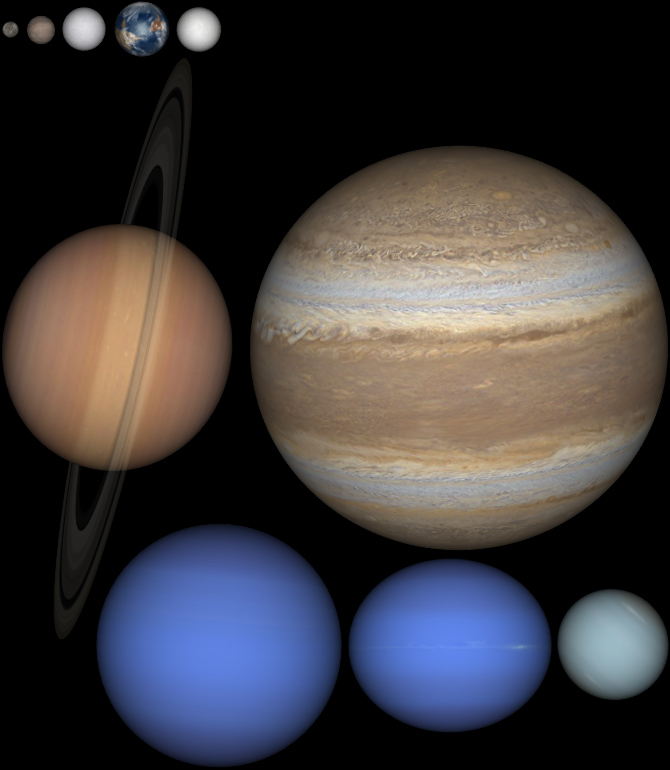
 |
| Right Ascension | 13h 18m |
|---|---|
| Declination | −18° 19' |
| Distance | 27.79 ± 0.16 ly |
| Spectral Class | G5V |
| Estimated Mass | 0.96 × Sol |
| Luminosity | 0.78 × Sol |
| 61 Virginis as seen from Sol. |
Sol as seen from 61 Virginis. |
|---|---|
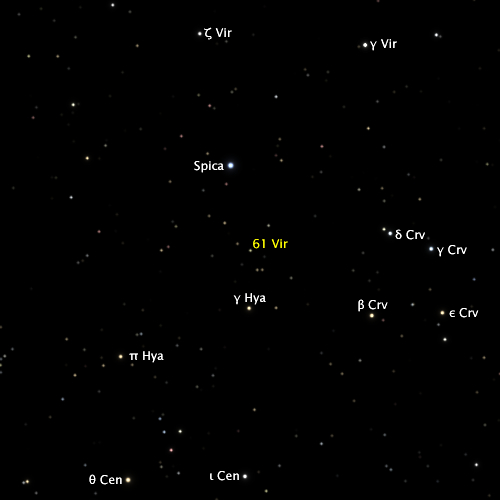 |
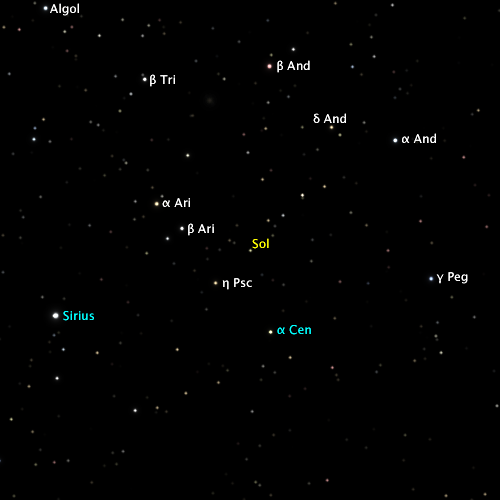 |
| Star | Magnitude | Distance |
|---|---|---|
| Arcturus | −1.01 | 23.6 |
| Canopus | −0.63 | 307.2 |
| Rigel | 0.21 | 875.5 |
| Beta Centauri (Hadar) | 0.50 | 372.1 |
| Betelgeuse | 0.50 | 509.1 |
| Achernar | 0.59 | 148.8 |
| Alpha Crucis (Acrux) | 0.64 | 303.1 |
| Spica | 0.73 | 222.1 |
| Theta Centauri (Menkent) | 0.88 | 34.3 |
| Alpha Aurigae (Capella) | 0.91 | 62.8 |
| Vega | 0.97 | 38.7 |
| Antares | 0.99 | 534.3 |
61 Virginis is a sunlike star with a spectral type of G5V. It is located 27.79 light years from Sol. This star is slightly less massive than Sol, and has a lumosity of 0.78 Sols.
| Destination | Distance |
|---|---|
| Gliese 432 | 14.9 |
| Gliese 581 | 14.4 |
| Wolf 424 A | 17.0 |
Probes from the Dandelion Project explored the system for the first time in 2930. The system has ten planets.
| Planet | SMA (AU) |
Orbital Period |
e | Equatorial Diameter (km) |
Mass (Earths) |
Density (g/cm3) |
Gravity (Earth g) |
Atmospheric Pressure (Earth=1) |
Sidereal Day |
Mean Solar Day |
Axial Tilt |
Known Moons |
|---|---|---|---|---|---|---|---|---|---|---|---|---|
| Rava | 0.2297 | 41.040 d | 0.0038 | 4296 | 0.02723 | 3.92 | 0.2399 | 0.00000300 | 41d 00h 56.9m | Synchronous | 00° 03.7' | 0 |
| Ferrugo | 0.3670 | 82.874 d | 0.0092 | 7524 | 0.1778 | 4.76 | 0.5106 | 0.00653 | 82d 20h 58.6m | Synchronous | 01° 03.7' | 0 |
| Formosis | 0.5942 | 170.75 d | 0.0158 | 11300 | 0.6348 | 5.02 | 0.8088 | 34.2 | 14d 11h 29.4m | 15d 19h 41.0m | 03° 28.8' | 0 |
| Humus | 1.011 | 1.0379 y | 0.0144 | 14470 | 1.487 | 5.62 | 1.155 | 2.96 | 22h 25.5m | 22h 28.8m | 15° 07.3' | 2 |
| Bellum | 1.609 | 2.0831 y | 0.0722 | 11780 | 0.5779 | 4.04 | 0.6775 | 0.0757 | 1d 15h 35.6m R | 1d 15h 30.5m | 162° 38.3' | 3 |
| Levitas | 6.229 | 15.865 y | 0.1023 | 68970 | 31.28 | 1.18 | 1.069 | &mdash | 10h 32.5m R | 10h 32.5m | 102° 09.1' | 14 |
| Magnus | 11.46 | 39.575 y | 0.0055 | 123000 | 200.7 | 1.27 | 2.157 | &mdash | 14h 50.4m | 14h 50.4m | 13° 25.1' | 14 |
| Caeruleus | 18.50 | 81.218 y | 0.0129 | 68280 | 31.05 | 1.12 | 1.083 | &mdash | 17h 53.2m | 17h 53.2m | 06° 41.0' | 15 |
| Ovatus | 27.47 | 146.91 y | 0.0230 | 55810 | 16.35 | 1.26 | 0.8535 | &mdash | 07h 00.6m | 07h 00.6m | 28° 54.2' | 11 |
| Nanus | 50.58 | 367.13 y | 0.1266 | 30090 | 4.904 | 2.11 | 0.8809 | &mdash | 14h 50.7m | 14h 50.7m | 41° 30.6' | 6 |
| Name | Diameter (km) |
Period (days) |
Semimajor Axis (km) |
Ecc | Inc |
|---|---|---|---|---|---|
| Natural Satellites of Humus | |||||
| Orbis | 1024 | 5.595 | 152000 | 0.0012 | 0.19 |
| Lapis | 53 | 17.12 | 320200 | 0.1574 | 5.42 |
| Natural Satellites of Bellum | |||||
| Pestis | 39 | 2.144 | 58500 | 0.0135 | 1.49 |
| Mors | 77 | 5.040 | 103400 | 0.0265 | 2.00 |
| Fames | 25 | 14.60 | 210200 | 0.0362 | 158.19 |
| Natural Satellites of Levitas | |||||
| Levitas V | 144 | 0.4803 | 81640 | 0.0002 | 0.00 |
| Levitas VI | 485 | 0.7741 | 112200 | 0.0159 | 0.02 |
| Levitas I | 1255 | 1.194 | 149800 | 0.0045 | 0.19 |
| Levitas II | 2030 | 2.996 | 276600 | 0.0082 | 0.17 |
| Levitas III | 1320 | 5.955 | 437300 | 0.0125 | 0.43 |
| Levitas IV | 1500 | 11.91 | 694400 | 0.0171 | 0.28 |
| Levitas VII | 623 | 29.64 | 1275000 | 0.0180 | 0.53 |
| Levitas IX | 115 | 29.64 | 1275000 | 0.0124 | 0.76 |
| Levitas VIII | 407 | 49.68 | 1799000 | 0.0220 | 4.53 |
| Levitas X | 91 | 89.96 | 2672000 | 0.2071 | 11.79 |
| Levitas XI | 38 | 285.4 | 5769000 | 0.1167 | 165.13 |
| Levitas XII | 50 | 388.3 | 7084000 | 0.2702 | 39.41 |
| Levitas XIII | 19 | 581.1 | 9269000 | 0.1462 | 147.69 |
| Levitas XIV | 31 | 581.3 | 9271000 | 0.1503 | 146.85 |
| Natural Satellites of Magnus | |||||
| Magnus V | 126 | 0.8155 | 215900 | 0.0005 | 0.02 |
| Magnus VI | 329 | 1.222 | 282700 | 0.0015 | 0.04 |
| Magnus IX | 95 | 2.059 | 400200 | 0.0020 | 0.03 |
| Magnus I | 2103 | 3.094 | 525100 | 0.0026 | 0.08 |
| Magnus II | 3572 | 6.119 | 827400 | 0.0035 | 0.22 |
| Magnus III | 1470 | 12.26 | 1315000 | 0.0047 | 1.44 |
| Magnus IV | 943 | 24.72 | 2099000 | 0.0022 | 2.33 |
| Magnus VII | 325 | 36.65 | 2729000 | 0.0102 | 1.40 |
| Magnus VIII | 332 | 64.75 | 3988000 | 0.0785 | 3.65 |
| Magnus XII | 19 | 112.1 | 5749000 | 0.2775 | 158.27 |
| Magnus X | 16 | 199.9 | 8455000 | 0.3259 | 41.39 |
| Magnus XI | 23 | 218.2 | 8964000 | 0.3200 | 40.96 |
| Magnus XIII | 18 | 227.2 | 9208000 | 0.3112 | 149.69 |
| Magnus XIV | 16 | 308.0 | 11280000 | 0.4002 | 13.27 |
| Natural Satellites of Caeruleus | |||||
| Caeruleus VII | 68 | 0.6762 | 102300 | 0.0010 | 0.00 |
| Caeruleus VIII | 60 | 0.7186 | 106500 | 0.0013 | 0.02 |
| Caeruleus IX | 52 | 0.7825 | 112700 | 0.0009 | 0.05 |
| Caeruleus I | 725 | 1.196 | 149600 | 0.0037 | 0.40 |
| Caeruleus II | 608 | 2.152 | 221300 | 0.0052 | 0.10 |
| Caeruleus III | 1340 | 3.581 | 310800 | 0.0044 | 0.24 |
| Caeruleus IV | 2038 | 5.380 | 407700 | 0.0016 | 0.38 |
| Caeruleus V | 1930 | 10.76 | 647000 | 0.0025 | 0.33 |
| Caeruleus VI | 907 | 26.84 | 1190000 | 0.0063 | 1.06 |
| Caeruleus X | 164 | 136.0 | 3512000 | 0.0466 | 7.73 |
| Caeruleus XI | 66 | 293.7 | 5867000 | 0.0682 | 19.73 |
| Caeruleus XIV | 41 | 312.5 | 6115000 | 0.0754 | 41.49 |
| Caeruleus XII | 71 | 451.5 | 7814000 | 0.1701 | 17.60 |
| Caeruleus XIII | 89 | 452.1 | 7822000 | 0.1693 | 17.55 |
| Caeruleus XV | 55 | 484.8 | 8194000 | 0.3683 | 155.78 |
| Natural Satellites of Ovatus | |||||
| Ovatus I | 434 | 0.4333 | 61390 | 0.0001 | 0.00 |
| Ovatus II | 841 | 0.7236 | 86410 | 0.0008 | 0.01 |
| Ovatus III | 761 | 1.448 | 137200 | 0.0002 | 0.01 |
| Ovatus IV | 581 | 2.173 | 179900 | 0.0003 | 0.00 |
| Ovatus V | 450 | 3.612 | 252400 | 0.0014 | 0.01 |
| Ovatus VI | 211 | 31.22 | 1063000 | 0.0631 | 9.93 |
| Ovatus VII | 168 | 56.24 | 1574000 | 0.0496 | 2.50 |
| Ovatus VIII | 173 | 83.89 | 2055000 | 0.1236 | 26.10 |
| Ovatus IX | 82 | 104.3 | 2376000 | 0.1453 | 156.84 |
| Ovatus X | 64 | 161.1 | 3174000 | 0.1645 | 167.22 |
| Ovatus XI | 42 | 737.2 | 8749000 | 0.4413 | 32.16 |
| Satellites of Ovatus XI | |||||
| 1 Ovatus XIA | 16 | 0.6124 | 67.66 | 0.0133 | 0.01 |
| Natural Satellites of Nanus | |||||
| Nanus III | 481 | 0.7291 | 58140 | 0.0011 | 0.01 |
| Nanus I | 1832 | 1.093 | 76140 | 0.0040 | 0.04 |
| Nanus II | 1406 | 2.183 | 120800 | 0.0064 | 0.06 |
| Nanus IV | 788 | 5.473 | 222900 | 0.0134 | 0.06 |
| Nanus V | 198 | 22.61 | 573800 | 0.0362 | 1.16 |
| Nanus VI | 68 | 137.4 | 1912000 | 0.4160 | 29.44 |
Derivation of name: Latin for “gray” with feminine suffix
Rava is a small world with no appreciable atmosphere or geological activity. It is heavily cratered.
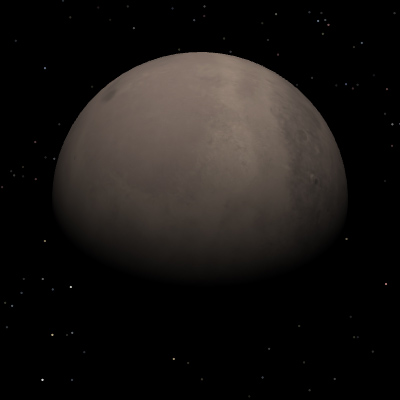 |
Derivation of name: Latin for “rust”
Ferrugo is a small, hot world with a thin atmosphere and covered with reddish dust. It is locked in synchronous rotation to its star. The synchronous rotation and thin atmosphere cause the less volatile gases such as water vapor and carbon dioxide to condense on the night side of the planet in a large ice cap. What atmosphere the planet still possesses is enriched with gases with lower condensation temperatures such as argon and nitrogen. The world has some craters, and the older craters show evidence of weathering by wind-borne dust.
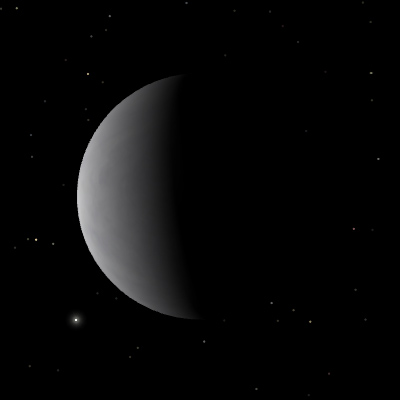 |
Derivation of name: Latin for “beautiful”, an allusion to Venus
Formosis is a world resembling Venus. It has a thick, hot atmosphere composed primarily of carbon dioxide. Like many such worlds, Formosis has endured a runaway greenhouse effect. Its slow rotation is a consequence of tidal locking; although the tidal locking process is not yet complete it is far advanced.
   |
 |
Derivation of name: Latin for “ground” or “soil”, an allusion to Earth
Out of all the systems explored within ten parsecs of the Sun, the world of Humus is the most Earthlike world discovered and explored so far. Humus is somewhat larger and more massive than the Earth, and this gives it a greater surface gravity. Its day is about seven per cent shorter than that of the Earth. The world is an active world — it has plate tectonics, rugged mountain ranges, and active volcanoes.
Humus has a thick atmosphere about three times as dense as the Earth’s atmosphere. Like Earth, the atmosphere is mainly composed of nitrogen (86.54%), oxygen (12.41%) and argon (0.83%), with carbon dioxide (0.22%) being more abundant than on Earth. Despite the relatively high atmospheric pressure, the atmosphere is breathable for humans because the partial pressures of the important atmospheric gases are all within the breathable ranges for humans.[1] The important gases are nitrogen (83% of maximum pressure for humans), oxygen (70% of maximum) and carbon dioxide (71% of maximum). On Humus, water boils at about 133.5°C.
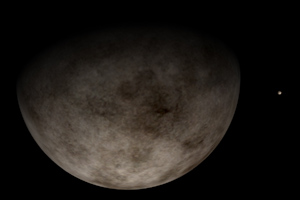 |
Humus has two moons. The larger moon, Orbis, orbits Humus in about five and a half days. Orbis is large enough to present familiar phases in the sky. Orbis cycles through its phases with disconcerting speed for an observer used to the leisurely cycle of phases of Earth’s moon: one night Orbis may be a thin crescent, on the next it has waxed to a half moon, and on the third it may be almost full. Even in the course of a single night, the phase of Orbis can change noticeably. Eclipse seasons for Orbis arrive around the time of the equinoxes. At these times, Orbis causes a series of three or four annular solar eclipses and experiences three or four total lunar eclipses. When Orbis eclipses the sun, the eclipse takes about fifteen minutes from start to finish.
The smaller moon of Lapis takes about 17 days to orbit once, and appears starlike due to its small size. Lapis is a moon with an irregular shape and is believed to be a captured planetoid.
Humus is home to alien life.
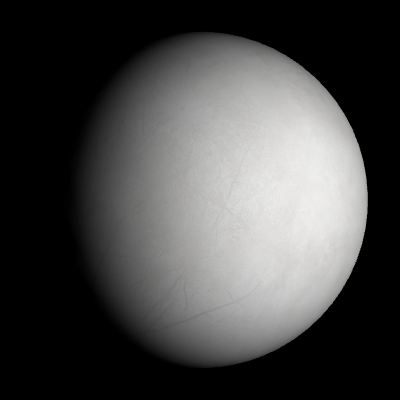 |
Derivation of name: Latin for “war”, an allusion to Mars
Bellum is an ice-covered world that resembles Europa, except it is much larger and the ice is smoother. The smoothness of the ice suggests that the world has a liquid ocean under the surface ice.
Superficially, Bellum strongly resembles its sibling world of Formosis; both worlds are of a similar size and from space appear as bright white orbs. The two world are quite different, however. Formosis is hot and dry and its appearance are due to thick clouds in a thick atmosphere, whereas Bellum is an ice-covered world with a thin atmosphere.
Bellum has a retrograde rotation. It also has three moons in direct orbits from the planet’s perspective. The moons and retrograde rotation are believed to originate from a planetary collision early in the history of this star system. For this reason, Bellum and its three moons are named after the Four Horsemen of the Apocalypse.
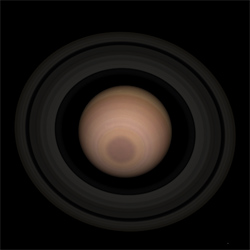 |
Derivation of name: Latin for “lightness” because the planet is of relatively low mass
Levitas is an odd world. In general appearance it is a small gas giant with about one third the mass of Saturn. The most striking feature of Levitas is the planet’s 102-degree axial tilt. This tilt is similar to Uranus in the Sol system, and is believed to have originated in a similar way — a planetary collision during the formation of the 61 Virginis system.
Levitas has a wide but fairly faint ring system. The world has 14 known moons, the four largest of which have diameters greater than 1000 kilometres.
 |
Derivation of name: Latin for “large”
The gas giant Magnus is the most massive planet in the 61 Virginis system. Its mass is about 0.63 Jupiter masses, and it orbits 61 Virginis with a period of about 39.5 Julian years.
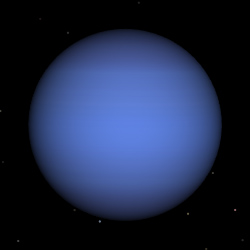 |
Derivation of name: Latin for “dark blue”
Caeruleus is a large Neptune-class planet that resembles Neptune in appearance.
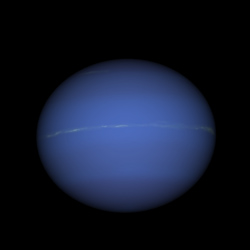 |
Derivation of name: Latin for “oval”
Ovatus is another Neptunelike world. Its rotation is unusually fast — one rotation takes just seven hours. This very rapid rotation gives the world a noticeably oblate shape, from which the world gets its name.
The moon Ovatus XI has its own satellite, Ovatus XIA. Satellite moons are unusual because most satellites are tidally locked to their planets which makes it impossible for satellite moons to have stable orbits. Ovatus XI lies outside the tidal lock radius of Ovatus which permits Ovatus XI to have its own moon.
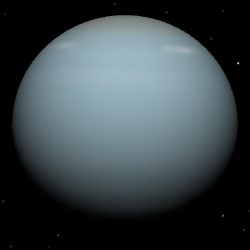 |
Derivation of name: Latin for “dwarf”
Nanus is an unusual world. It is an ice subgiant, which is a world like an ice giant but smaller in size. Nanus has a mass only about five times that of the Earth.